
|
Top 50 Underappreciated Recent Films35) Big Trouble
--Big Trouble is the victim of some of the worst movie timing in history. A whimsical, slapstick Dave Barry take on Floridays, the film had the unfortunate subplot of terrorists taking a bomb on an airplane and an originally scheduled release date of 9/21/2001. Ouch. When this goofy Tim Allen/Rene Russo project finally did make it to theaters half a year later, there was still no way to comfortably market it so Big Trouble became viewed as nothing more than a tax write-off for Disney. Even had the film not been cursed by fate, it still would have struggled to find an audience because it's just too random for the average cinephile. There is no real story to the film but rather it's a series of unfolding events, each of which is established in order to give excellent comedians a chance to sell broad, physical jokes. This list includes Stanley Tucci giving a toe job, Andy Richter disgracing the entire profession of security guard, Denis Farina ranting about the quality of talk radio and Patrick Warburton running nude through an airport terminal. And I haven't even mentioned Martha Stewart or the Toad From Hell yet. Big Trouble is just too weird for the average person but it's exactly this surreal off-kilter style of comedy which sets it apart from the cookie cutter Hollywood releases we so often suffer through. Director Barry Sonnenfeld remembers that the first rule of humor is to make the viewer laugh early and often. And he certainly delivers the goods in this regard. It's a virtual lock to make my top ten of 2002 and it's recently released on video and dvd so run, don't walk, to the videostore right freakin' now. (David Mumpower/BOP) 34) Sling Blade
That may not sound like a ringing endorsement, but it really is the highest of praise. Truthfully, what more can you ask of a film than to keep you entertained, emotionally invested and make you want to be a better person? For the Michael Bay fans out there, that answer is probably explosions and more quarter-second cuts. But since this write-up is more than five words long, I'm sure I've already lost their interest anyway. Sling Blade is not meant for our ADD-like MTV culture. It's a slow burn, but one that should set a fire inside you. Karl Childers is a matricide who has spent most of his life in a mental institution for his crime. At first, Karl's a caricature. With his Forrest Gump-like haircut and Southern drawl, Billy Bob Thornton seems like a drunk at a party in Kentucky doing a bad Rain Man impression. However, once we hear his tale of murder and parental abuse, Billy Bob shines through. His Karl is at once gentle and quietly violent. These are products, respectively, of his genetics and abusive upbringing. It helps that Thornton wrote, directed and starred in this film. The images on-screen are those of a singular inventor. The pacing and cinematography let the film takes its time to develop. What does develop is a heartbreaking friendship between Karl and a young boy, Frank. Frank has also lost a parent, and is being verbally abused by his mother's boyfriend, Doyle Hargraves (played brilliantly by Dwight Yoakam). Eventually, Karl must make the choice between his newly-found freedom or saving his friend from Doyle. His choice is one of ultimate sacrifice. Not only does Karl land himself back into the institution that he never should have been released from, but he knowingly damns himself, all for the safety of Frank. Karl's action is a bitter pill to swallow. Did he do the right thing? For a morality tale, it certainly leaves this as a grey area. What we do learn for sure is that nothing bad should happen to children. In the end, with Karl staring blankly out his institution's window, Sling Blade shows what Forrest Gump, for all its magic, only said: Karl may not be a smart man, but he knows what love is. (David Parker/BOP) 33) Mallrats
After the critical success Smith experienced with his self-financed debut Clerks, expectations were high for his second effort. Needless to say, critics were disappointed and the film barely registered at the box office. But Kevin Smith fans love the film, which marked the first appearances of later Smith regulars Ben Affleck, Jason Lee, and Joey Lauren Adams. It's not the best picture Smith has ever made, but his mall opus has more than enough moments to qualify it as being severely underappreciated. (Les Winan/BOP)
--Though it is certainly the slightest film in the Kevin Smith Jersey repertoire, Mallrats is nonetheless a fun little homage of sorts to the John Hughes films of the '80s as well as being a hilarious compendium of both obscure and obvious fanboy references. It's a true product of pop culture, with allusions to films as varied as The Night of the Hunter, Jaws, The Blues Brothers, Batman, Butch Cassidy and the Sundance Kid and the Star Wars trilogy. Despite the fact that the script is disjointed and relies a bit too much on toilet humor to make its points, Mallrats is still a clever, strongly dialogue-driven film that rings true for a generation of slackers. More importantly, Mallrats introduced Jason Lee as a capable and charismatic lead actor. With this film, the former professional skateboarder became a fixture in every subsequent Smith film, not to mention drawing critical raves as Stillwater lead singer Jeff Bebe in Cameron Crowe's Almost Famous. Mallrats also officially established Jay and Silent Bob as cult icons, leading to further and more expanded appearances in Chasing Amy, Dogma and obviously Jay and Silent Bob Strike Back. Eminently quotable and hilariously biting and sardonic, it's a film that pulls few punches and doesn't hesitate to cross the line. It appeals to the mainstream common denominator even as it excludes them with in-jokes and quirky references. Mallrats certainly isn't a film for everyone, but Smith does offer a unique look at Gen-X slacker culture that just isn't found in similar films of the genre. (Kim Hollis/BOP) 32) Dazed and Confused
Dazed and Confused has an amazing array of actors packed into the film. As with American Graffiti and Fast Times at Ridgemont High before it, Dazed and Confused has one of those casts where you marvel at how many actors "made it big". A young Ben Affleck, Matthew McConaughey, and Parker Posey all have supporting roles. This is one of those rare films centering around high school that seems "real". There's no stilted plot device of an all-day detention or prom to throw the characters together, no message about being yourself or learning that the cool kids aren't as cool as they seem; the characters just act like kids most of us went to high school with. That's the beauty of Dazed and Confused; it's one of the most true-to-life visions of life as a teenager captured on film. (Stephanie DeGateo/BOP) --While Dazed and Confused never received the attention from moviegoers that it deserved, critics also did not lambaste it. Richard Linklater's film chronicling the last day of school in 1976 not only boasts a veritable all-star cast of soon-to-be-well-known actors (Ben Affleck, Renée Zellweger, Milla Jovovich, Parker Posey, and Matthew McConaughey) and a variety of well-known bit players, it's well made, well performed, and engaging. Additionally, it's extremely funny. Starting off with an Aerosmith song and never looking back, music drives the plot of Dazed and Confused through the day, setting the mood for the scenes and perfectly complementing the storylines. It's a shame that well-crafted, intelligent films like this do not have more drawing power on initial release, but a welcome relief when, like Dazed and Confused, they find their popularity on video. (Les Winan/BOP)
31) Bound
--Bound was the first sign that there might be something special about these Wachowski boys. In Bull Durham parlance, the brothers announced their presence with authority by writing and directing this thrilling tale of a new couple who are thrown up against the mafia. The twist in Bound is that the lovers are new friends Corky and Violet, who happen to both be women. Violet is stuck in a horrible relationship with evil mob thug Ceasar, so when her recently incarcerated new neighbor moves in, she makes the calculated decision to escape her current life by seducing Corky. Much to her surprise, Violet falls hard for the butch woman and when an opportunity arises to set up Ceasar and steal millions from the mob, they shrug off the potential consequences and pull off the dangerous heist. Even if we ignore one of the sexiest love scenes in the history of cinema, Bound would still be deserving of at least cult status if not mainstream success. There is gripping tension in several scenes as we see what Ceasar and his cohorts are capable of doing to those who cross them. From there, clever plot turns put Violet in the eye of the storm as she must deceive mafia members into believing her so that she can buy herself and her lover the opportunity to get the hell out of Dodge. There is never a moment where the viewer can be sure of their fate until the credits roll, a fitting accomplishment for the men who would go on to create the Star Wars-crushing Matrix series. As for the seduction scene itself, there's no way to describe it without dancing about architecture. I'll simply say that I consider Bound as a movie to be a wonderful entrée and the sequence where Violet reveals her tatoo to be a dessert worthy of an Iron Chef. (David Mumpower/BOP)
Click here to read selections 50-46.
|
Friday, January 02, 2026
© 2006 Box Office Prophets, a division of One Of Us, Inc.
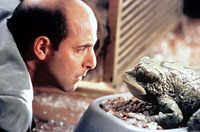 --Okay, so it's from this year, but this is already one of the most underappreciated films around. Moved after September 11 because the plotline revolves mainly around a bomb on an airplane, it was pretty much buried in March of 2002 and became one of the larger flops of the year. Everyone missed a very funny adaptation of a truly hysterical novel by columnist Dave Barry. With a talented comedic ensemble (yes, even Johnny Knoxville) and quality material, Big Trouble would be destined for cult status in a perfect world. (Tim Briody/BOP)
--Okay, so it's from this year, but this is already one of the most underappreciated films around. Moved after September 11 because the plotline revolves mainly around a bomb on an airplane, it was pretty much buried in March of 2002 and became one of the larger flops of the year. Everyone missed a very funny adaptation of a truly hysterical novel by columnist Dave Barry. With a talented comedic ensemble (yes, even Johnny Knoxville) and quality material, Big Trouble would be destined for cult status in a perfect world. (Tim Briody/BOP)
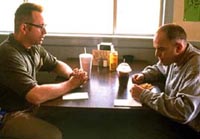 All great morality tales do the same thing: They take you on a road where
the end is apparent from the start. Though where you are in the end isn't
what matters, nor is how you got there, but more that you won't want anyone
(in real life) to ever reach that road's end again. Sling Blade is such a
morality tale.
All great morality tales do the same thing: They take you on a road where
the end is apparent from the start. Though where you are in the end isn't
what matters, nor is how you got there, but more that you won't want anyone
(in real life) to ever reach that road's end again. Sling Blade is such a
morality tale.
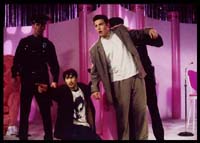 --Kevin Smith's critically-reviled cult rental Mallrats began as a broad comedy ode to the John Hughes comedies of Smith's formative years. By the time the marketing campaign for the movie rolled around, it was being presented as something entirely different, and the only thing certain about that ad campaign is that it was entirely wrong.
--Kevin Smith's critically-reviled cult rental Mallrats began as a broad comedy ode to the John Hughes comedies of Smith's formative years. By the time the marketing campaign for the movie rolled around, it was being presented as something entirely different, and the only thing certain about that ad campaign is that it was entirely wrong. 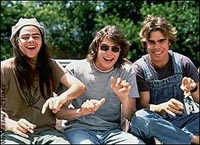 It's the last day of the 1975-76 school year at Robert E. Lee High School,
and everyone is looking for a good time. Everyone but the incoming
freshmen, as the good old boys at Robert E. Lee High haze their soon-to-be
ninth graders. Dazed and Confused follows a large group of characters -
upper classmen, freshman, jocks, nerds, cool kids and losers alike - as they
search for sex, drugs, booze, solace and the meaning of life. Don't look
for a plot; as in Slacker, Richard Linklater's first prominent film, not
much actually happens. Instead, characters ruminate on scoring (drugs, sex
and touchdowns), life after high school, and whether or not rules are made
to be broken. Oh yeah, and they party. A lot.
It's the last day of the 1975-76 school year at Robert E. Lee High School,
and everyone is looking for a good time. Everyone but the incoming
freshmen, as the good old boys at Robert E. Lee High haze their soon-to-be
ninth graders. Dazed and Confused follows a large group of characters -
upper classmen, freshman, jocks, nerds, cool kids and losers alike - as they
search for sex, drugs, booze, solace and the meaning of life. Don't look
for a plot; as in Slacker, Richard Linklater's first prominent film, not
much actually happens. Instead, characters ruminate on scoring (drugs, sex
and touchdowns), life after high school, and whether or not rules are made
to be broken. Oh yeah, and they party. A lot.
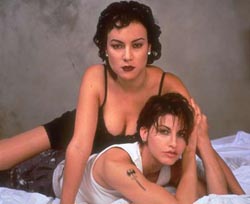 --Bound is a movie that looks like it cost ten times as much as it did. This
film is like an onion when it comes to all the cool things it features. The
script, first off, is a mind-bendingly clever story that features more
backstabbing and more edge-of-your-seat scenes than a movie should legally
have. On top of that, the film is visually original and exciting. The
cinematography complements some truly fascinating shots where the camera
moves in sly and witty ways. Even the much-lauded love scene is a technical
masterpiece in how it completely spins around a room without revealing
what's behind the magic and without using any CGI. The blending of a great
screenplay and kick-ass visuals is exactly why Bound is on our top 50 list.
(Walid Habboub/BOP)
--Bound is a movie that looks like it cost ten times as much as it did. This
film is like an onion when it comes to all the cool things it features. The
script, first off, is a mind-bendingly clever story that features more
backstabbing and more edge-of-your-seat scenes than a movie should legally
have. On top of that, the film is visually original and exciting. The
cinematography complements some truly fascinating shots where the camera
moves in sly and witty ways. Even the much-lauded love scene is a technical
masterpiece in how it completely spins around a room without revealing
what's behind the magic and without using any CGI. The blending of a great
screenplay and kick-ass visuals is exactly why Bound is on our top 50 list.
(Walid Habboub/BOP)